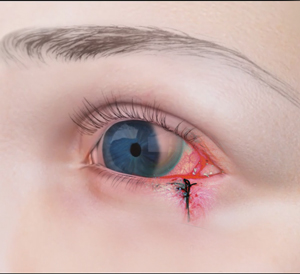
An enhanced understanding of ocular tumors and improved diagnostic capabilities in recent years has resulted in a variety of treatment options for orbital tumors. Depending on your particular condition, surgical options include:
OSSN excision+CRYO+AMG
OSSN or Ocular surface squamous neoplasia is an umbrella term for tumors that begin in the conjunctiva and may eventually invade the cornea. The traditional treatment method for OSSN is the surgical excision of the tumor. This surgery uses a 'no-touch technique', implying that the tumor is not touched with any surgical instruments during the surgery. This is done to reduce the risk of tumor seeding (spread of a tumor to adjoining tissues). During this surgery, absolute alcohol is applied over the corneal component of OSSN. The alcohol brings about cellular devitalization allowing the tumor cells to be easily peeled off. The peeled tumor cells are sent for pathological examination.
Double freeze-thaw cryotherapy is applied to the corneal limbus (border of cornea and sclera) and conjunctival margins. Cryotherapy is believed to reduce the recurrence rate by killing the residual tumor cells if any. Also, as wide margins are recommended in the surgical excision of the tumor, the ocular surface is often left with a large size defect. An AMG (amniotic membrane graft) is used to cover the defect. The AMG is secured on to the sclera with fibrin glue.
Lacrimal gland biopsy
Lacrimal glands are the almond-shaped glands located above and to the side of each eye. Occasionally, the cells in this gland start multiplying abnormally, resulting in a tumor of the lacrimal gland. Lacrimal gland biopsy involves the removal of a small amount of tissue for microscopic examination in order to make a definite diagnosis of cancer.
Intralesional steroid injection
Intralesional steroids are injected just inside the septum in the rim of the orbit to treat certain types of orbital tumors. Triamcinolone acetonide is a commonly used intralesional steroid.
Orbital Incisional Biopsy
During this procedure, a moderate amount of tissue is surgically removed from the mid or posterior orbit and sent to a pathologist for examination. The excised tissue is usually representative of the abnormal orbital tumor. This surgery is performed under general anesthesia.
Lipodermoid/dermoid/epidermoid excision
Lipodermoid, dermoid and epidermoid are conditions that develop when a normal tissue overgrows in an abnormal location. They differ from each other in composition and their respective locations in the eye. Surgical excision is recommended in dermoid and epidermoid conditions if the patient suffers from irritation and disturbance of vision. During the surgery, the skin overlying the dermoid is cut open along with the adjoining tissues to reveal the dermoid. The dermoid is then excised free of the surrounding tissue. Surgery is very rarely recommended in lipodermoids because of associated complications.
Orbitotomy +debulking
The surgical biopsy to examine and make a definite diagnosis of orbital tumors is called orbitotomy. There are different types of orbitotomy such as Lateral Orbitotomy, Anterior Orbitotomy, Medial Orbitotomy and a combination of the Lateral and Medial Orbitotomies. One of these different orbitotomy procedures is used depending on the location and the size of the tumor. At times, it is not possible or advisable to remove the entire tumor. In such instances, only a part of the malignant tumor is removed by a surgery called debulking.
Exenteration
Exenteration of the orbit is a surgical procedure to treat potentially life-threatening malignant tumors that involve the eyelids or structures around or behind the eye. This is an extensive surgery during which the eyeball, the surrounding tissue, conjunctiva, and eyelids are removed. The socket is reconstructed with the help of a split-thickness skin graft usually taken from the thigh. Exenteration surgery is a 'last-resort' surgery undertaken only when the tumor cannot be completely removed by other treatment interventions that leave the eyeball intact with the hope of retaining vision.
Conjunctival biopsy + AMG
The conjunctival biopsy is a safe diagnostic procedure for well-circumscribed (with definite boundaries) anterior orbital tumors that include hemangioma, schwannoma, and soft tissue dermoid cysts. During this procedure, an incision is made in the fornix (space behind the eyelids) of the conjunctiva. Using scissors and cotton applicator sticks, blunt dissection is carried out until the tumor is exposed. The next attempt is directed to extract the tumor intact. The tumor sample is sent to a pathologist for microscopic examination. An AMG (innermost layer of the placenta) is used to reconstruct the conjunctival defect following the removal of the tumor. The conjunctival biopsy is simple, has low morbidity, is cost-effective and is a less time-consuming procedure.
Related Topics
- Cataract
- Glaucoma
- Eyelid Disorders
- Dry Eyes
- Blepharitis
- Chalazion
- Tear Duct Obstruction
- Refractive Errors
- Subconjunctival Hemorrhage
- Pterygium
- Hyphema
- Herpetic Eye Disease
- Acute/ Chronic/Recurrent Iridocyclitis
- Chemical Burn
- Conjunctival & Corneal tear
- Repair of Conjunctival and Corneal tear
- Corneal Opacity
- Corneal Ulcer
- Ocular/Orbital Trauma
- Treatment of Ocular/Orbital trauma
- Eyelid Cyst
- Optic Nerve Atrophy
- Optic Neuropathy
- Pars Planitis/Intermediate Uveitis
- Posterior Uveitis
- Diseases of Cornea
- Temporal Arteritis
- Traumatic Iritis
- Ocular/Orbital Tumors
- Pediatric Eye Problems

